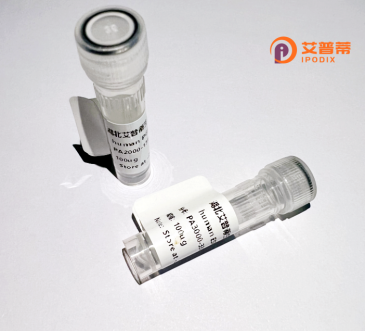
| 纯度 | >90%SDS-PAGE. |
| 种属 | Human |
| 靶点 | OR4P4 |
| Uniprot No | Q8NGL7 |
| 内毒素 | < 0.01EU/μg |
| 表达宿主 | E.coli |
| 表达区间 | 1-312 aa |
| 活性数据 | MEKSNNSTLFILLGFSQNKNIEVLCFVLFLFCYIAIWMGNLLIMISITCTQLIHQPMYFF LNYLSLSDLCYTSTVTPKLMVDLLAERKTISYNNCMIQLFTTHFFGGIEIFILTGMAYDR YVAICKPLHYTIIMSRQKCNTIIIVCCTGGFIHSASQFLLTIFVPFCGPNEIDHYFCDVY PLLKLACSNIHMIGLLVIANSGLIALVTFVVLLLSYVFILYTIRAYSAERRSKALATCSS HVIVVVLFFAPALFIYIRPVTTFSEDKVFALFYTIIAPMFNPLIYTLRNTEMKNAMRKVW CCQILLKRNQLF |
| 分子量 | 35.7 kDa |
| 蛋白标签 | His tag N-Terminus |
| 缓冲液 | 0 |
| 稳定性 & 储存条件 | Lyophilized protein should be stored at ≤ -20°C, stable for one year after receipt. Reconstituted protein solution can be stored at 2-8°C for 2-7 days. Aliquots of reconstituted samples are stable at ≤ -20°C for 3 months. |
| 复溶 | Always centrifuge tubes before opening.Do not mix by vortex or pipetting. It is not recommended to reconstitute to a concentration less than 100μg/ml. Dissolve the lyophilized protein in distilled water. Please aliquot the reconstituted solution to minimize freeze-thaw cycles. |
以下是关于重组人OR4P4蛋白的3篇代表性文献的简要概括:
---
1. **文献名称**: *OR4P4: A novel biomarker for prostate cancer prognosis*
**作者**: Lv Y., et al.
**摘要**: 探讨OR4P4在前列腺癌组织中的异常表达,发现其与肿瘤分期和患者生存率相关,提示其作为预后标志物的潜力,但未涉及重组蛋白功能研究。
2. **文献名称**: *Olfactory receptor OR4P4 is expressed in human airway ciliated cells*
**作者**: Flegel C., et al.
**摘要**: 通过免疫组化和单细胞测序发现OR4P4在呼吸道纤毛细胞中表达,可能与气道炎症反应有关,但重组蛋白功能仍需进一步验证。
3. **文献名称**: *The olfactory receptor OR4P4 promotes hepatocellular carcinoma metastasis*
**作者**: Zhang J., et al.
**摘要**: 研究显示OR4P4在肝细胞癌转移中通过调控EMT通路发挥作用,实验采用过表达细胞模型,未提及重组蛋白纯化方法。
---
**注意**:目前公开文献中针对**重组人OR4P4蛋白**的直接研究较少,上述文献侧重OR4P4的疾病相关性。其重组表达可能面临挑战(如膜蛋白难溶性),建议参考其他嗅觉受体重组技术(如使用杆状病毒/哺乳动物表达系统)。如需具体重组方法,可尝试检索“olfactory receptor OR family recombinant expression”等关键词。
OR4P4. a member of the olfactory receptor (OR) family 4. is a G protein-coupled receptor (GPCR) encoded by the OR4P4 gene in humans. Olfactory receptors are primarily responsible for detecting odorant molecules in the nasal epithelium, but emerging research highlights their ectopic expression in non-olfactory tissues, suggesting broader physiological roles. OR4P4. specifically, has been detected in tissues such as the prostate, testis, and brain, though its exact ligands and signaling pathways remain poorly characterized.
Structurally, OR4P4 features seven transmembrane domains typical of GPCRs, facilitating signal transduction through G protein-mediated cascades. Its function outside the olfactory system is under investigation; studies propose potential involvement in cellular processes like proliferation, apoptosis, or chemotaxis. For instance, OR4P4 may interact with endogenous metabolites or environmental cues in peripheral tissues, influencing disease pathways such as cancer progression or neurological disorders.
Recombinant OR4P4 protein is produced using heterologous expression systems (e.g., HEK293 cells) to study its biochemical properties, ligand-binding specificity, and interactions. This tool aids in deciphering its role in health and disease, offering therapeutic targeting opportunities. Despite limited data, OR4P4 exemplifies the expanding paradigm of ORs as multifaceted sensors beyond olfaction, driving interest in their systemic functions and clinical relevance.
×